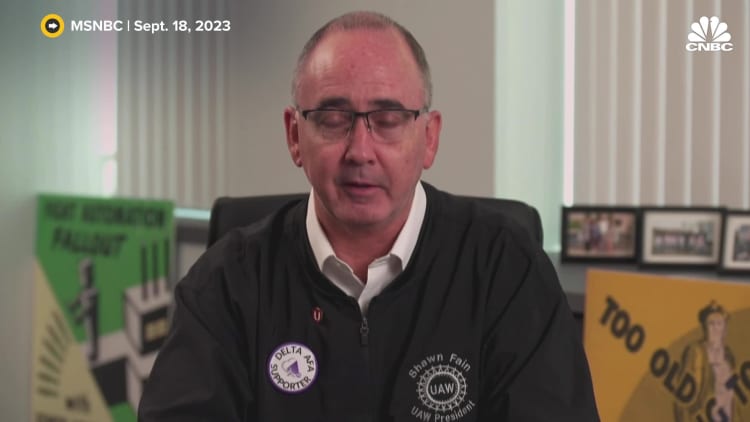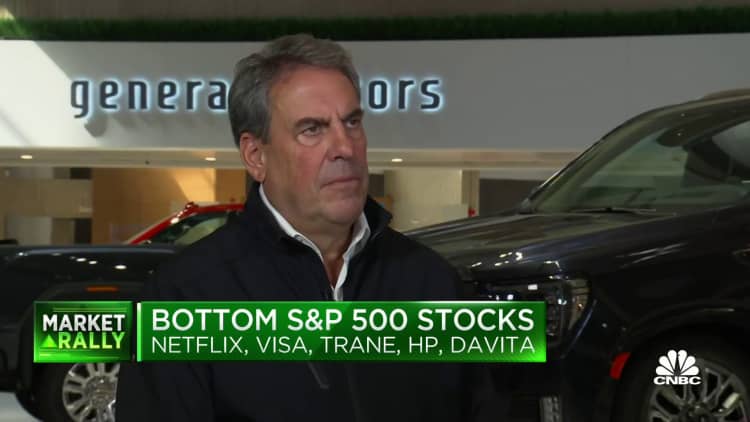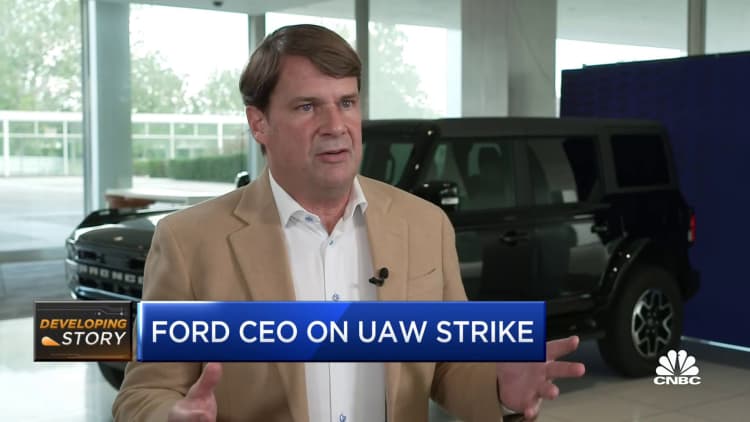(L-R) Supporter Ryan Sullivan, and United Auto Workers members Chris Sanders-Stone, Casey Miner, Kennedy R. Barbee Sr. and Stephen Brown picket outside the Jeep Plant on September 18, 2023 in Toledo, Ohio.
Sarah Rice | Getty Images
DETROIT – As the United Auto Workers (UAW) approach their deadline for expanded strikes against Detroit automakers, the prospects for “serious progress” seem uncertain.
Currently, both the UAW and the Detroit automakers – General Motors (GM), Ford Motor (Ford), and Stellantis (Stellantis) – are maintaining their respective demands, which suggests that the union will strike additional plants as promised.
Talks have been ongoing, but little progress has been made since the strikes began on September 15. Sources familiar with the negotiations describe a significant gap between the two sides.
The main issues being discussed include wages, retirement benefits, cost-of-living adjustments, wage progression, work-life balance, and more. Each automaker has its own unique concerns, but all of them want to avoid fixed costs and practices like traditional pensions, which they consider uncompetitive. Meanwhile, the UAW is trying to regain lost benefits, secure substantial pay increases, and maintain platinum healthcare for its members.
Ultimately, the total cost of the deal is the primary concern for the companies. Wall Street predicts record costs, but they are still below the union’s demands of $6-8 billion, according to Wells Fargo.
Now, let’s take a look at where each side stands on the key issues.
Wages
The UAW has been transparent about its demand for a 40% wage increase over four and a half years. However, reports suggest that the union has adjusted its demand to the mid-30% range. So far, the automakers have countered with wage increases of around 20% over the length of the contract, which would still be a record. The companies are also offering a top wage of over $39 per hour for most workers. It is believed that if the companies increase hourly wages beyond 20%, they may reduce benefits or jobs in the future to compensate.

Ford’s proposal includes starting salaries of around $60,000 for entry-level employees, with the potential to increase to $100,000 or more during the contract. GM’s latest offer includes a base wage of about $82,000 per year for approximately 85% of current employees, which is higher than the median household income in areas where GM has major assembly plants.
Tiers/In-progression/Temps
Wage tiers have been a contentious issue throughout the negotiations. The UAW has advocated for equal pay for equal work, while the automakers argue for different pay based on factors like seniority and job responsibilities. The introduction of “tiers” in 2007 allowed for lower wages and benefits for workers hired after that year, leading to pay disparities between newer and veteran workers. The union is pushing to eliminate these pay tiers entirely.

The automakers have proposed cutting the existing eight-year pay progression in half and reducing pay discrepancies between workers in similar roles. The union wants to eliminate the in-progression pay structure and ensure equal wages for all workers, including temporary employees. Ford has agreed to convert all current temporary workers with 90 days of work into full-time employees, while the other automakers have not made similar concessions.
COLA/Profit-sharing
The UAW wants to reinstate cost-of-living adjustments (COLA), while the automakers have proposed lump-sum payments or inflation-based calculations that the union believes are inadequate. The companies argue that profit-sharing payments based on North American profits have helped offset inflation. However, the UAW wants enhanced profit-sharing formulas.

The automakers are looking to change or reduce profit-sharing payments to counter other increased costs, while the UAW wants a more favorable formula. The union has proposed $2 for every $1 million spent on share buybacks and increased dividends.
32-hour workweek
The UAW is seeking a better work-life balance, including a potential 32-hour workweek for the pay of 40 hours. However, the automakers are not in favor of a shorter workweek and have offered additional vacation time, holiday pay, and paternal leave as alternatives.
Product
Product commitments are crucial to the UAW as they directly relate to job security. The union is concerned about Stellantis’ plans to close, sell, or consolidate 18 facilities, including its North American headquarters and manufacturing components. In contrast, GM has committed to product allocations for all its facilities following previous closures.
Retirement Benefits and Savings
The UAW is demanding increased pay for retired workers. While the union claims that the companies have rejected all increases, GM has proposed a $500 lump-sum cash payment for retirees. Ford’s current offer includes a health care retirement bonus program with lump sums ranging from $35,000 to $50,000, based on seniority. The automakers are resistant to traditional pensions and prefer 401(k) plans.
Notably, Ford’s proposal includes a 6.4% contribution from the company and $1 per hour for every hour worked, without a cap.
GM has also offered an unconditional 6.4% company 401(k) contribution for employees without pensions.










